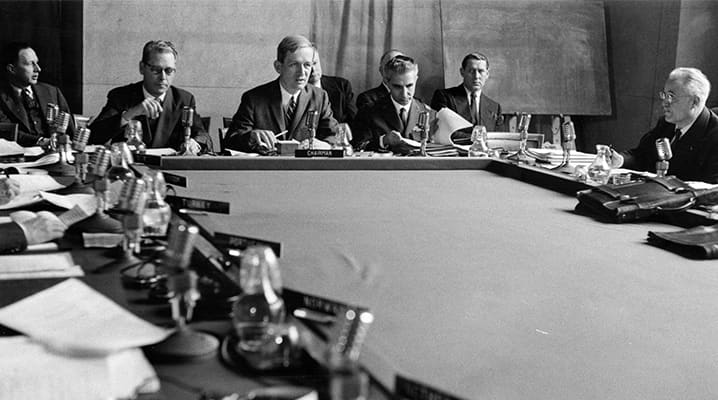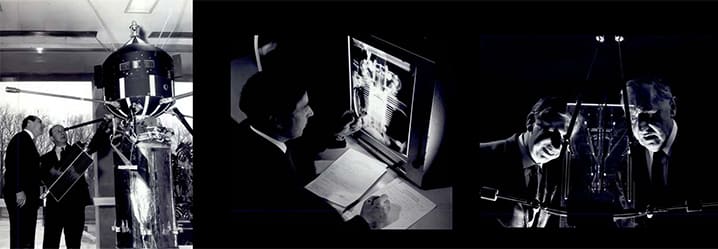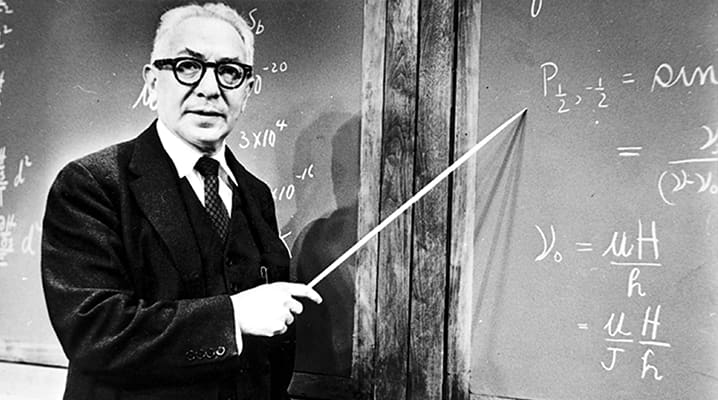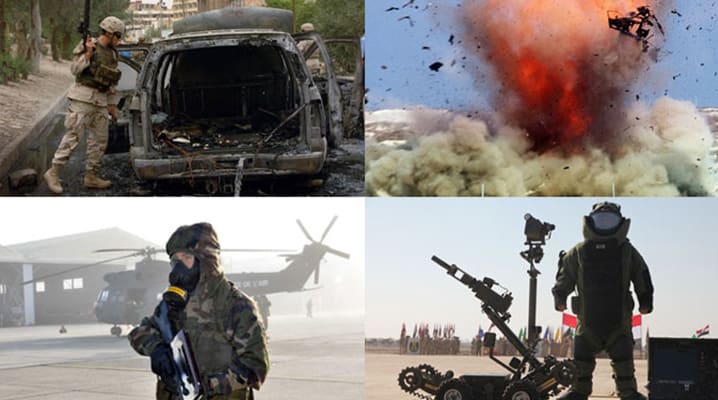The end of March marks the 60th anniversary of the establishment of the NATO Science Committee and the creation of the position of Science Adviser to the NATO Secretary General in 1958. Looking back at the evolution of NATO’s sponsorship of scientific research over the past six decades, science historian Simone Turchetti explains how it has also served to foster constructive dialogue among Allies, furthering the integration of the Alliance.
NATO’s Science for Peace and Security (SPS) Programme currently sponsors research activities between scientists from Allied member states and NATO partner countries across the world. The details of ongoing studies and funding opportunities are widely disseminated, but we know far less about the scheme’s origins. When did it begin and how did it develop?

The first Science Committee meeting took place on 29 March 1958. NATO's first Science Advisor was Professor Norman F. Ramsey, who was later awarded the Nobel Prize for his contributions to Atomic Physics. © NATO
A limited portion of the documents of its predecessor programme developed under the aegis of the Science Committee, is now available at the NATO Archives and sheds new light on the wider legacy of the Alliance’s investment in science. Crucially, it reveals the importance of this sponsorship, which started exactly sixty years ago, for the advancement of science as much as for the Allies’ relations at the height of the Cold War. We now know that the promotion and elaboration of a science programme informed past efforts to establish a constructive dialogue between delegations exactly when the Allies needed it, virtually working as a device for parallel diplomacy.
By the late 1950s, when the scheme was first set up, NATO was much in demand of diplomatic work especially in light of the difficulties preventing its integration. French and British officials disputed that the United States alone should control its nuclear deterrent. Italy and Turkey agreed to host it notwithstanding these anxieties, but Norwegians and Danes did not want nuclear weapons on their soil. The Suez crisis made these disagreements spectacularly apparent and led NATO’s “Three Wise Men” ̶ the foreign ministers of Italy, Norway and Canada ̶ to write a report emphasising the importance of finding better ways to integrate the Alliance. It hinted, notably, to an investment in scientific research to strengthen it.
The ministers were prophetic indeed as, after the launch of the first Soviet satellite Sputnik, the North Atlantic Council instructed the setting up of a Science Committee. And from April 1958, a newly-appointed Assistant Secretary General for Scientific Affairs (or NATO Science Adviser) invited prominent Western scientists to meet regularly to elaborate a sponsorship programme.
Over the following fifty years, no less than three generations of illustrious researchers contributed to the shaping of the NATO science programme, which resulted in a multi-layered scheme comprising fellowships to study abroad, the organisation of lecture-driven seminars (the Advanced Study Institutes) and research grants for innovative projects.
By the early 1960s, NATO’s investment rose to five million US dollars each year and grew even more, especially when inflation hit Western economies harder leading to proposals for budget increases. The delegates’ conversations on research grants in particular helped establish a constructive dialogue among Allies, as they worked together to identify which subjects to prioritise and set up sub-groups devoted to specific studies. Consensus building produced political synergies or, at least, helped to evade deeper disagreements in critical moments of the Alliance’s history.
Changing trajectories
In its early days, the Committee’s recommendations aligned to the post-Suez rapprochement between US and UK administrations that had just, in great secrecy, signed a mutual defence agreement. This support steered NATO science in the direction advocated by US representatives moulding what the third Science Adviser, US physicist William Nierenberg, dubbed as the scheme’s “mixed philosophy”. It meant sponsoring science as a way to propel integration and, at the same time, address defence requirements. For instance, it paid projects designed by a committee’s sub-group devoted to oceanographic research since these studies improved NATO’s naval operations (and especially anti-submarine warfare).
Some of the first scientific cooperation initiatives included: a model of the Anglo-American satellite “UK2” put into orbit in 1964 (left) and a pulse mode modulator facilitating the transmission of television picture (right). © NATO
Spearheaded by the Nobel prize-winning US radar pioneer Isidor Isaac Rabi, with the assistance of British zoologist (and operational research maestro) Baron Solomon (‘Solly’) Zuckerman, this funding philosophy was soon revised, however, partly because the US-UK partnership did not last for long. John F. Kennedy’s decision to remove nuclear missiles from Turkey without prior Allied consultation on the occasion of the 1962 Cuban missile crisis, and the renunciation of the production of the Skybolt missile (which had been promised to the United Kingdom) upset transatlantic relations and, in turn, materialised a dissent on the trajectory of NATO’s science programme.
Moreover, during the second half of the 1960s, other delegates hoped to steer the science programme towards different directions. Allies with less developed economies (Italy, Greece, Portugal and Turkey) jointly asked to revisit NATO’s investment in science so as to address their mounting technology gap with the United States. But Rabi and officials at the US State Department were against using this investment as assistance to economic development. The confrontation further isolated the US delegation, especially as, with the conflict in Vietnam ongoing, West Germans canvassed support for establishing a dialogue with Eastern bloc countries and the Belgian foreign minister, Pierre Harmel, was about to release a report recommending that the Alliance should play a greater role in promoting political détente.
NATO’s political and scientific affairs had by then already reached breaking point. In October 1966, a tense Science Committee meeting took place in Portugal and the Nobel-laureate French physicist, Louis Néel, stated that his administration would vehemently oppose a budget increase. French President Charles de Gaulle then announced France’s exit from the Alliance’s integrated military structure – and as a consequence, NATO’s headquarters moved from Paris to Brussels. But the quarrel on the Committee’s future continued as an “Exploratory Group of Six”, formed by the Committee’s leading members, now proposed its dissolution.
A new environmental focus
The Committee did not shut down, however, partly because of Rabi’s protracted efforts to keep it alive. Aware that NATO’s science programme could no longer align to defence concerns and unconvinced about development, he now argued for prioritising scientific research to address environmental problems during the 1968 celebrations of the Committee’s 10th anniversary.
Had Rabi solicited such an investment because he believed a dialogue on environmental sustainability would provide diplomacy returns no longer available through science? Or was he genuinely embracing the environmental sentiment then spreading across Western countries? What we know is that Rabi was as prophetic as the Three Wise Men had previously been. The following year, US President Richard M. Nixon advocated the launch of a NATO environmental programme and a Committee on the Challenges of Modern Society (CCMS) was set up to coordinate actions in the environmental field.
This anticipated the Science Committee’s re-organisation too. In October 1969, the Committee met for the first time at the US State Department and on that occasion the German engineer, Eduard C. Pestel, openly supported Rabi’s propositions. This was partly because he had recently contributed to environmental sustainability studies in the context of the prestigious Club of Rome. However, their consensus echoed wider synergies on environmental policies and political affairs then developing between West Germans and the US administration.

Nobel Prize-winning physicist and US radar pioneer Isidor Isaac Rabi helped keep the Science Committee alive in the late 60s and argued for prioritising scientific research to address environmental problems. © www.thefamouspeople.com
The shift in NATO’s sponsorship agenda also informed changes in research practices leading, for instance, to innovative environmental monitoring exercises. Instrumentation and techniques used in previous studies were now made available to CCMS sub-groups charting air and sea pollution. One of them even rose to fame when, in 1974, it plotted the environmental impacts associated with the sinking off the Adriatic coasts of a Yugoslav cargo, Cavtat, containing noxious fuel additives.
Promoting stability
With the 1980s approaching, the focus of NATO’s investment in science shifted once more. The Committee’s 20th anniversary led to a diversification of its programme and the Science Committee now advocated the beginning of “Science for Stability”. An assistance scheme alien to Rabi’s funding philosophy, it targeted Greece, Portugal and Turkey alone. It was introduced when the Turkish mechanical engineer, Nimet Özdas – who had contributed to the technology gap debate of a decade earlier – was in office as NATO’s Science Adviser. It was elaborated in the recognition that the promotion of science could work as a stabilising force in times of greater political volatility.
Science for Stability tailed off with the rise to power of UK Prime Minister Margaret Thatcher and US President Ronald Reagan, which re-ignited the Cold War demanding greater political and economic strength. The long-standing Cyprus dispute had by then weakened the Alliance as a multi-lateral organization due to the ongoing conflict between Turkey and Greece. Meanwhile unemployment was rampant in most Allied countries. NATO’s new scheme sought indirectly to address these issues and evolved in three phases (1979-1986, 1987-1993, 1994-1997), for a total investment of 46 million US dollars.
In 1980, French physicist Robert Chabbal eventually replaced Özdas as Science Adviser. His appointment in a historical period, when France was not integrated in NATO’s military structure, further demonstrated how the promotion of science at NATO could work as a device of parallel diplomacy. It anticipated, notably, the re-alignment of French and US governments that followed French President François Mitterrand’s instatement at the Elysée Palace.
Science for Peace and Security
In the 1990s, the blending of science and political affairs at NATO was more compelling than ever as a solid-state physicist turned politician, the Spanish Javier Solana – who, as foreign minister, had led Spain’s integration process in 1986 – was appointed NATO Secretary General. With him at the helm of the Alliance, more countries became members, especially after the collapse of the Warsaw Pact and the Soviet Union.
NATO was now “able to successfully reinvent itself, to change with the times before obsolescence risked to take over,” according to Jamie Shea (currently serving as NATO’s Deputy Assistant Secretary General for Emerging Security Challenges). Science was instrumental to NATO’s “reinvention” as the Science Committee first, and the Science for Peace and Security (SPS) Programme from 2006, prioritised the sponsorship of collaborative research with Eastern European countries to promote closer partnership and cooperation with the Alliance.

As part of NATO’s new Emerging Security Challenges Division in 2010, the NATO Science for Peace and Security Programme started prioritising challenges such as cyber defence, counter-terrorism, energy security, and defence against chemical, biological, radiological and nuclear agents. © NATO
For many years, Russia was the largest beneficiary of sponsorship until the illegal annexation of Crimea in 2014 led to the suspension of NATO’s collaboration with Russian scientists. At the same time, the SPS Programme stepped up its collaboration with Ukraine that replaced Russia as its main beneficiary. Large-scale SPS projects (e.g. humanitarian demining, mine detection and the development of telemedicine) helped Ukraine build capacity to deal with the consequences of the conflict. From 2010, the SPS programme had already moved to NATO’s newly-established Emerging Security Challenges division; something that reconfigured further the Alliance’s investment. The programme has since then adopted a stronger security outlook mirroring the portfolio of the Division and prioritising emerging security challenges such as cyber defence, counter-terrorism, energy security and defence against chemical, biological, radiological and nuclear agents.
It would take someone as visionary as Rabi was to see what lies ahead for NATO science in the 21st century. But its past can now be charted with a greater degree of accuracy. Cast, Janus-like, between competing ambitions to bolster security and propel relations between Allies often at odds, NATO’s investment now appears to have been inspired by more than just the aspiration to dispassionately support novel research. Indeed, it can now be told that the Alliance’s endurance as a multilateral organisation has, to a surprising extent, been supported by the opportunities for constructive exchange that its Science Committee generated over the second part of the 20th century and beyond.
Further Reading:
A book charting the history of NATO’s science (S. Turchetti, Greening the Alliance: The Diplomacy of NATO’s Science and Environmental Initiatives, Chicago: University of Chicago Press, November 2018) is forthcoming. Quantitative data on NATO’s science programme can be found in several NATO official publications (e.g. Facts About the Activities of the Science Committee of the North Atlantic Treaty Organization, Paris: NATO, 1967). On NATO’s oceanography see: S. Turchetti, “Sword, Shield and Buoys: A history of the NATO sub-committee on oceanographic research, 1959-1973,” Centaurus 54/3 (2012), 205-31; Lino Camprubí and Sam Robinson. “A Gateway to Oceanic Circulation: Submarine Surveillance and the Contested Sovereignty of Gibraltar,” Historical Studies on the Natural Sciences 46/4 (2016), 429-59. Jamie Shea’s words are from “The Berlin Wall Comes Down and the Soldiers Go Home,” available at: http://www.nato.int/60years/video/videos-jamie.html.
